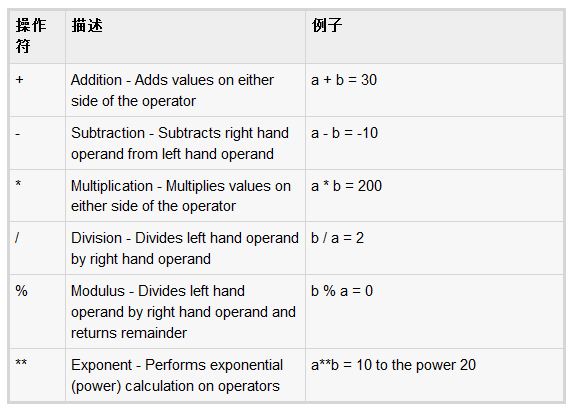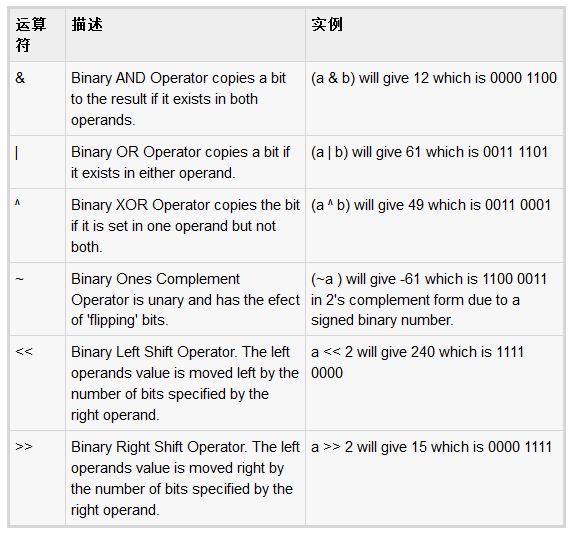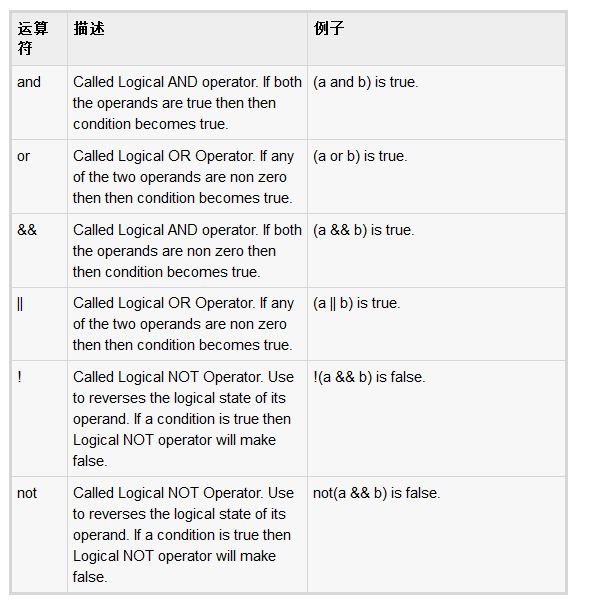萬盛學電腦網 >> 網絡編程 >> 編程語言綜合 >> 詳解Ruby當中的算數運算
詳解Ruby當中的算數運算
Ruby支持一系列豐富的運算符的一個現代化的語言。大多數運算符實際上是方法調用。例如,a + b的被解釋為a,
+(b)變量引用的對象的方法被稱為一個用b作為它的參數。
對於每個運算符 (+ - * / % ** & | ^ << >> && ||), 有相應的賦值運算符縮寫形式 (+= -= 等)
Ruby算術運算符:
假設變量a=10,變量b=20:

Ruby比較操作符:
假設變量a=10,變量b=20:

Ruby賦值運算符:
假設變量a=10,變量b=20:

Ruby並行賦值:
Ruby還支持並行賦值的變量。這使得多個一行Ruby代碼來初始化變量。例如:
?
1 2 3 a = 10 b = 20 c = 30需要更迅速聲明,使用並行賦值:
?
1 a, b, c = 10, 20, 30並行賦值交換兩個變量的值也是有用的:
?
1 a, b = b, cRuby位運算符:
位運算符位和位操作執行位。
假設當a =60和b=13;現在以二進制格式將如下:
?
1 2 3 4 5 6 7 8 9 10 11 12 13 a = 0011 1100 b = 0000 1101 ----------------- a&b = 0000 1100 a|b = 0011 1101 a^b = 0011 0001 ~a = 1100 0011支持Ruby語言的位運算符

Ruby邏輯運算符:
支持Ruby語言的邏輯運算符
假設變量a=10,變量b=20:

Ruby三元運算符:
還有一個運算符稱為三元運算符。這首先計算一個表達式為true或false值,然後執行一個計算結果來決定兩個語句的哪一個。條件運算符的語法如下:

Ruby范圍運算符:
Ruby中的序列范圍是用來創建連續值 - 組成了開始值/結束值,並在兩者之間的值的范圍內。
在Ruby中,創建這些序列使用“..”和“...”范圍運算符。這兩個點的形式建立一個包容性的范圍,而三個點的形式創建了一個范圍,不包括指定的最大值。

Ruby defined? 操作符:
defined是一個特殊的操作符采取的形式的方法調用,以確定是否通過表達式定義。如果沒有被定義的表達式,它返回一個描述字符串求解出的表達式或nil
有很多種用法 defined操作符:
用法 1
?
1 defined? variable # True if variable is initialized例如 :
?
1 2 3 4 foo = 42 defined? foo # => "local-variable" defined? $_ # => "global-variable" defined? bar # => nil (undefined)用法 2
?
1 defined? method_call # True if a method is defined例如 :
?
1 2 3 defined? puts # => "method" defined? puts(bar) # => nil (bar is not defined here) defined? unpack # => nil (not defined here)用法 3
?
1 2 # True if a method exists that can be called with super user defined? super例如 :
?
1 2 defined? super # => "super" (if it can be called) defined? super # => nil (if it cannot be)用法 4
?
1 defined? yield # True if a code block has been passed例如 :
?
1 2 defined? yield # => "yield" (if there is a block passed) defined? yield # => nil (if there is no block)Ruby "." 雙冒號 "::" 運算符:
調用一個模塊方法,通過模塊的名稱和句點它的名字前,引用一個常數使用該模塊的名稱和兩個冒號。
::使得一元運算符,常數,實例方法和類方法在類或模塊定義,從任何地方訪問外的類或模塊。
請記住:在Ruby中,類和方法可以被視為常數。只需要前綴::Const_name的表達式返回相應的類或模塊對象。
如果沒有前綴表達式時,主要對象類默認情況下使用。
這裡有兩個例子:
?
1 2 3 4 5 6 7 8 9 10 11 12 13 14 15 16 17 18 19 20 21 22 23 24 25 26 27 28 29 30 MR_COUNT = 0 # constant defined on main Object class module Foo MR_COUNT = 0 ::MR_COUNT = 1 # set global count to 1 MR_COUNT = 2 # set local count to 2 end puts MR_COUNT # this is the global constant puts Foo::MR_COUNT # this is the local "Foo" constant Second Example: CONST = ' out there' class Insi- 上一頁:詳細解析Ruby中的變量
- 下一頁:Ruby中注釋的使用方法



